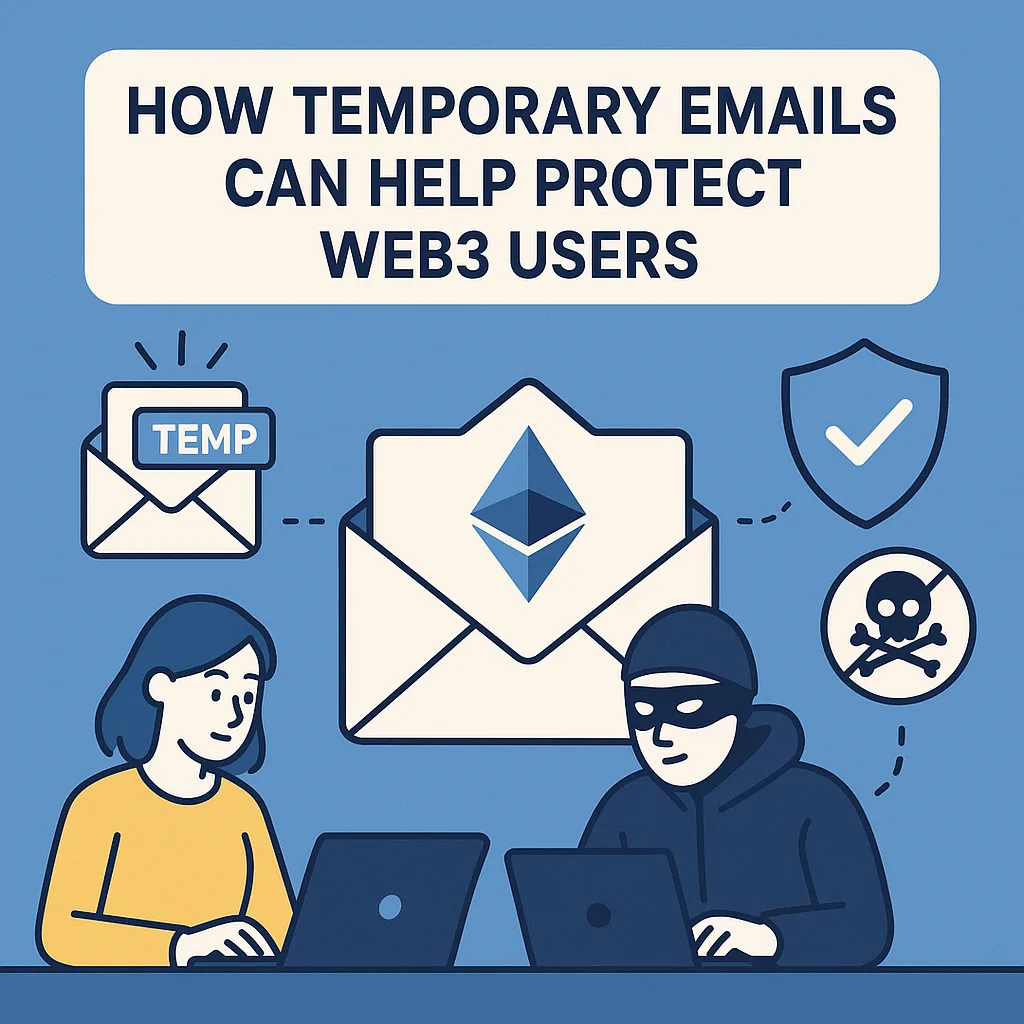The internet is being revolutionized by Web3. This new internet frontier promises transparency, freedom, and ownership through decentralized finance (DeFi), non-fungible tokens (NFTs), decentralized autonomous organizations (DAOs), and decentralized applications (dApps). But great innovation also comes with great risk, particularly in terms of data protection and user privacy.
In the Web3 ecosystem, many users often overlook a crucial vulnerability: email addresses. Whether you’re signing up for a new dApp, participating in a crypto airdrop, or testing a decentralized exchange, your email can become a point of exposure. That’s where temporary email services like 10minutesmails and mytemp-mail come in. These tools offer a powerful layer of anonymity and protection for Web3 users.
In this blog, we’ll explore:
-
Why privacy is critical in Web3
-
Risks tied to using your primary email
-
Benefits of temporary email services
-
How tools like mytemp-mail and 10minutesmails help secure your identity
-
Best practices for integrating temp mail into your Web3 habits
What Is Web3 and Why Does Privacy Matter?
The next generation of the internet, known as Web3, is based on decentralized technologies like smart contracts and blockchain. Web3 seeks to give users ownership of their data and assets, in contrast to Web2 platforms (such as Facebook or Google), which are governed by corporations.
But while your wallet address might be pseudonymous, your email address isn’t.
In many Web3 interactions, emails are still required for:
-
Account verification
-
Newsletter subscriptions
-
Access to token sales or NFT drops
-
Connecting with DAOs or community platforms
-
Crypto airdrop registrations
Unfortunately, using your real email in these situations creates a trail—one that can be exploited for:
-
Phishing attacks
-
Targeted scams
-
Data harvesting
-
Unwanted spam
-
Identity linking
The Risk of Using Personal Emails in Web3
Using your everyday email address when interacting with decentralized platforms can result in serious consequences, including:
🎯 Targeted Phishing Scams
Web3 users are particularly vulnerable to phishing attacks. Hackers steal wallet credentials or seed phrases by sending phony emails that seem to be from trustworthy platforms. You become a target if your private email is made public through leaks or sign-ups.
🧩 Identity Correlation
Blockchain wallets are pseudonymous, but you can de-anonymize your on-chain activity by linking them to a personal email. Users in nations with stringent financial regulations or those attempting to protect their privacy are particularly at risk from this.
📩 Spam Overload
A deluge of promotional emails may result from taking part in token sales, airdrops, or dApp betas. In addition to wasting time, this clutter makes it more likely that you will overlook crucial messages amidst the deluge of spam.
🛡 Data Breaches
Even decentralized platforms sometimes use centralized systems for user management. If they’re breached, your personal email could be leaked or sold on the dark web.
Enter Temporary Emails: A Web3 User’s Privacy Shield
Temporary email services generate disposable email addresses that last for a short duration—usually between 10 minutes to a few hours. They allow users to receive emails, complete sign-ups, or verify accounts without revealing their real identity.
Services like mytemp-mail and 10minutesmails are designed to help users protect their personal inbox and avoid long-term digital footprints.
Benefits of Using Temp Mails in Web3
✅ Enhanced Anonymity
With a temporary email, you avoid linking your Web3 activity to your real identity. This is especially important for:
-
Privacy-focused DeFi users
-
DAO contributors
-
NFT collectors who want anonymity
-
Crypto investors testing risky or experimental platforms
✅ Spam Prevention
Sending brief emails helps keep your inbox free of spam. You can use a disposable email and then delete it after you're done, rather than overflowing your primary inbox with promotional material.
✅ Safe Participation in Airdrops
Email verification is frequently required for airdrops. You can join without jeopardizing your primary email or leaving yourself vulnerable to scams in the future by using mytemp-mail or 10minutesmails.
✅ Reducing Attack Surface
Keeping your primary email off dubious or unconfirmed platforms lessens your exposure to social engineering, targeted attacks, and leaks.
✅ Convenience
No need to register, set up, or delete accounts. Temp emails are instant, disposable, and perfect for quick interactions.
Use Cases of Temporary Emails in the Web3 Ecosystem
Here’s how Web3 users are integrating temp mail into their daily crypto activities:
🪙 1. Joining Crypto Airdrops and Token Launches
Airdrops often require emails for claim verification or whitelist registration. Instead of exposing your main email, use 10minutesmails to complete the process safely.
🧪 2. Testing New DeFi or NFT Platforms
Since many dApps are still in beta, their security procedures might not be the best. When registering or exploring features, using mytemp-mail safeguards your inbox and true identity.
🎮 3. Exploring Web3 Gaming Platforms
Early access is occasionally provided by play-to-earn games in return for email signups. Check them out with a disposable email before providing your actual information.
🤖 4. Signing Up for Web3 Tools, Newsletters, or Waitlists
Web3 is booming with new tools, including analytics dashboards, tax software, and wallet trackers. You can avoid needless subscriptions and freely explore them with a temporary email.
🏛 5. Participating in DAOs and Community Forums
For communication or participation in governance, many DAOs require email. To protect your privacy, think about using a temporary email address if you're only joining one to look around.
Best Practices When Using Temp Mails in Web3
While temporary email services are incredibly useful, you should follow some best practices for maximum benefit:
🔐 1. Never Link Temp Emails to Sensitive Wallets
If a platform requires linking to a wallet, make sure it’s not your primary or high-value one. Use burner wallets when combining with temp emails.
🧾 2. Save Any Confirmation or Token Info Immediately
Since temp mails expire, download or record any access tokens or confirmation links right away.
🔍 3. Don’t Use Temp Mail for Long-Term Accounts
If you need ongoing access (e.g., for a newsletter or dashboard), consider using a secondary permanent email instead of a temp one.
🔒 4. Combine with VPNs and Privacy Browsers
To truly remain anonymous while using Web3 apps, combine temp mail usage with:
-
VPNs (like ProtonVPN, Mullvad)
-
Privacy browsers (like Brave or Firefox with strict settings)
Why Choose 10minutesmails and mytemp-mail?
These two platforms stand out among temp email providers for Web3 users:
-
Instant email generation
-
Clean UI with no sign-up required
-
Automatically deletes email after 10 minutes
-
Ideal for airdrops, token claim verifications
-
Offers a longer email lifespan (customizable duration)
-
Ability to view email history for a set period
-
Great for testing platforms that take longer to send verification
Both tools are free, fast, and designed for users who value privacy and digital minimalism—core principles of the Web3 movement.
Final Thoughts
Web3 promises ownership, decentralization, and freedom. However, users must take privacy into their own hands in order to realize that vision. In a world where spam campaigns, phishing scams, and data leaks are frequent occurrences, your email address becomes one of the most neglected weaknesses.
By using temporary email services like mytemp-mail and 10minutesmails, Web3 users can:
-
Protect their real identities
-
Safely explore new projects
-
Reduce spam and clutter
-
Avoid becoming targets of crypto-related scams
Temp mails are simple, effective, and free—making them a no-brainer for any privacy-conscious Web3 user.
In the decentralized world, you are your own data guardian. So take control, use temp mail wisely, and navigate Web3 with the privacy and security it was meant to provide.




Leave a Reply